Sustunable offers and trades the following tuna species:
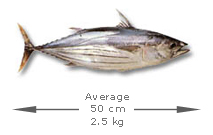
| English: | Skipjack Tuna (stripe-bellied Bonito) |
| Latin: | Katsuwonus pelamis |
| Size + Weight: | Average today abt 35 cm abt 3kg |
| Biggest Angled Fish: | 18 kgs , Mauritius 1971 by Joseph Caboche jr. |
| Catching Areas: | 55% Western Pacific Ocean 12% Eastern Pacific 20% Indian Ocean |
| Catching Methods: | Mostly purse seining |
| Share of all Tuna Caught: | About 50-55% or 1.500.000 m/t |
| Life Cycle: | About 3 years max. |
Size, Age, and Growth:
The maximum length of a Skipjack tuna is about 108 cm fork-length with a maximum weight of 32.5 to 34.5 kg. However, nowadays a more common size is about 35 cm fork-length and 3.0 kg in weight.
Reproduction:
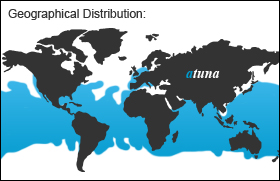 Skipjack tuna are oviparous, they spawn all year-round in the warm equatorial waters, while further away from the equator spawning season is limited to the warmer months.
Skipjack tuna are oviparous, they spawn all year-round in the warm equatorial waters, while further away from the equator spawning season is limited to the warmer months.
Sexual maturity may occur at a length of 15 inches (40 cm), however most fish appear to mature at larger sizes. It has been known that larger females produce significantly more eggs than smaller females, with the average female adult producing 80,000 to 2 million eggs per year. The eggs are approximately 0.94 mm in diameter, with a clear shell. The larvae hatch at a size of 3.0 mm. They have large heads and jaws, and a lack of body pigmentation. By closely observing the larvae, they can be distinguished by their pigmented forebrains. Like most Thunnus species (with an exception of the Bluefin tuna) they also lack pigment in the caudal region.
Stock Status of Skipjack Tuna:
| Ocean | Regional Management Organization |
State of Stock |
Last Edited |
Indian Ocean |
IOTC |
Fully exploited |
Year 2007 |
Eastern Pacific Ocean |
IATTC |
Moderately exploited |
Year 2007 |
Western and central Pacific Ocean |
WPFMC |
Moderately exploited |
Year 2007 |
Eastern Atlantic Ocean |
ICCAT |
Moderately exploited |
Year 2006 |
Western Atlantic Ocean |
ICCAT |
Moderately exploited |
Year 2006 |
Conservation:
The populations of skipjack tuna in the Atlantic Ocean have appeared to be declining in recent years while populations in the Pacific Ocean appear to be stable. At this moment, the skipjack tuna is not listed as threatened or endangered in.
Sustunable Approach for Skipjack
NO skipjack tuna which has been caught through the use of FAD’s by purse seiners, by using driftnets or gillnets, bottom trawling or obtained through illegal fishing will be delivered through Sustunable. Also NO juvenile undersized skipjack will be accepted.
ONLY skipjack which has been caught by setting nets on free swimming schools and skipjack which have had a full breeding life and a weight between 1.8 and 5.0 kgs. Fishing will not take place in any spawning area.
ONLY skipjack caught by either purse seining, by pole & line or hand line.
We assure that our methods have an absolute minimum by-catch, and leave the eco-system balance in tact. Independent observers on-board will assure that these goals are met.
Through the Sustunable on-line tracing system – any consumer buying a tuna product supplied by our company – will be able to trace back exactly by which boat and which captain his skipjack was caught and which responsible fishing method has been used.

| English: | Yellowfin Tuna |
| Latin: | Thunnus albacares |
| Size + Weight: | Today about 40-180 cm abt 5-20 kg |
| Biggest Angled Fish: | 175 kgs, Mexico 1977 by Curt Wiesenhutter |
| Catching Areas: | 25% Eastern Pacific 35% Western Pacific 25 % Indian Ocean 15% Atlantic Ocean |
| Catching Methods: | Mostly purse seining, also long-line |
| Share of all Tuna Caught: | About 35% or 1.100.000 m/t |
| Life Cycle: | About 4-7 years |
Size, Age, and Growth:
The maximum length reported for Yellowfin tuna is 280 cm total length and the maximum weight is 400 kg. The all-tackle record recognized by the International Game Fish Association (IGFA) is 176.4 kg. The latter also indicates the more common maximum size for this species.
Reproduction:
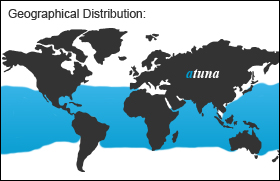 The size of Yellowfin tuna at maturity varies by region, and could also vary between individuals found near- and offshore. Yellowfin reach the status of mature by the time they reach a length of 120 cm in fork length at an age of about 2 to 3 years; however there are some exceptions where fish become mature at the size of 50 to 60 cm in fork length at an age of about 12 to 15 months. The sex ratio is approximately 1:1 in juvenile fishes and adults up to 140 cm.
The size of Yellowfin tuna at maturity varies by region, and could also vary between individuals found near- and offshore. Yellowfin reach the status of mature by the time they reach a length of 120 cm in fork length at an age of about 2 to 3 years; however there are some exceptions where fish become mature at the size of 50 to 60 cm in fork length at an age of about 12 to 15 months. The sex ratio is approximately 1:1 in juvenile fishes and adults up to 140 cm.
The reproduction of Yellowfin tuna occurs all year-round, but is most frequent during the summer months in each hemisphere. In the tropical waters of Mexico and Central America, it has been determined that Yellowfin spawn at least twice a year. It is believed that 26°C is the minimum temperature for spawning and each female spawns several million eggs per year.
Among the tuna species, the larval of Yellowfin tuna can be identified by a lack of pigment on the tail and by the presence of a single spot of black pigment under the chin.
The Yellowfin juveniles grow quickly, weighing approximately 3.4 kg at 18 months and 63.5 kg at 4 years.
Stock Status of Yellowfin Tuna:
Ocean |
Regional Management Organization |
State of Stock |
Last Edited |
Atlantic Ocean |
ICCAT |
Fully exploited |
Year 2007 |
Indian Ocean |
IOTC |
Moderately/fully |
Year 2007 |
Eastern Pacific Ocean |
IATTC |
Fully exploited |
Year 2007 |
Western and central Pacific Ocean |
WPFMC |
Fully exploited |
Year 2007 |
Conservation:
The Yellowfin tuna is currently listed of having a low risk and least concern in the redlist of World Conservation Union (IUCN).
Sustunable Approach for Yellowfin
NO yellowfin tuna which has been caught through the use of FAD’s by purse seiners, by using driftnets, gillnets, or bottom trawling or obtained through illegal fishing, will be delivered through Sustunable. Also NO juvenile undersized yellowfin will be accepted into our products.
ONLY yellowfin which has been caught by setting nets on free swimming schools and yellowfin which have had a full breeding life and a weight between 15 and 100 kgs are accepted. Fishing will not take place in any spawning area.
ONLY yellowfin caught by either purse seining on schools or hand line. In case long lining is used, then special circle hooks and other special pre-cautions should be taken to avoid any by-catch of sharks, marine mammals, turtles or seabirds. Only long liners with a proven record of fishing sustainable will be acceptable.
We assure that our methods have an absolute minimum by-catch, and leave the eco-system balance in tact. Independent observers on-board will assure that these goals are met.
Through the Sustunable on-line tracing system – any consumer buying our yellowfin product – will be able to trace back exactly by which boat, which captain, and exactly where his yellowfin was caught and which responsible fishing method was used.
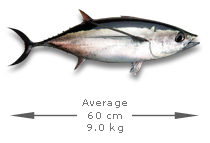
| English: | Albacore Tuna (long finned tuna) |
| Latin: | Thunnus alalunga |
| Size + Weight: | Average today abt 68 cm abt 20-45 lbs, peak weight 85 lbs (1 lbs = 0.44 kg.) 40 kgs Spain |
| Biggest Angled Fish: | 1977 Siegfried Dickeman |
| Catching Areas: | 40% Northern Pacific 27% Southern Pacific 25% Atlantic Ocean + Mediterranean 8% Indian Ocean |
| Catching Methods: | Pole and Line, surface trolling and long-line fishing |
| Share of all Tuna Caught: | About 7 % or 225.000 m/t |
| Life Cycle: | About 5 years |
Size, age and growth:
Maximum fork length of the albacore tuna is 127 cm. The all-tackle angling record is a 40 kg fish with a fork length of 123 cm, caught in the Canary Island in 1977.
Reproduction:
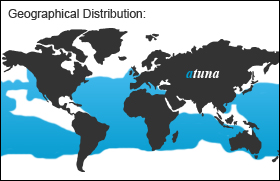 Fishery in the pacific surface (pole-and-line, and troll fishery), smaller sizes of albacore tuna (sizes between 55 to 80 cm fork length) predominate, while long-line fisheries will catch bigger fishes (sizes between 95 to 115 cm fork length). In the Indian Ocean, common sizes of albacore range from 40 to 100 cm fork length, while in the Atlantic Ocean males up to 109 cm and females up to 106 cm are not exceptional.
Fishery in the pacific surface (pole-and-line, and troll fishery), smaller sizes of albacore tuna (sizes between 55 to 80 cm fork length) predominate, while long-line fisheries will catch bigger fishes (sizes between 95 to 115 cm fork length). In the Indian Ocean, common sizes of albacore range from 40 to 100 cm fork length, while in the Atlantic Ocean males up to 109 cm and females up to 106 cm are not exceptional.
In the Pacific Ocean, maturity may be attained at about 90 cm in females and at about 97 cm fork length in males; in the Atlantic Ocean it is reached at about 94 cm in both sexes. In the subtropical waters of Pacific Ocean centered around the 20º N and 20º S latitude, peak spawning of albacore tuna is generally believed to be occurring. From March through July on the grounds located in the western and central Pacific Ocean it is assumed where the North Pacific albacore stock spawns.
Albacore tuna are believed to be pelagic spawners that broadcast their gametes in open water, often near the surface, with fertilization being externally done. An estimation of female fecundity (number of eggs) range from 0.8 to 2.6 million eggs per spawning (roughly 100,000 eggs per kg of body weight). The eggs are approximately 1 mm in diameter and remain buoyant by an enclosed oil droplet and develop very rapidly, with hatching occurring within 24 to 48 hours.
Stock Status of Albacore Tuna:
| Ocean | Regional Management Organization |
State of Stock |
Last Edited |
North Pacific Ocean |
IATTC, WCPFC |
Fully exploited |
Year 2007 |
South Pacific Ocean |
IATTC, WCPFC |
Fully exploited |
Year 2007 |
Eastern Pacific Ocean |
IATTC |
Moderately exploited |
Year 2007 |
Southwestern Pacific Ocean |
WPFMC |
Moderately exploited |
Year 2007 |
Indian Ocean |
IOTC |
Fully exploited |
Year 2004 |
North Atlantic Ocean |
ICCAT |
Overfished |
Year 2007 |
South Atlantic Ocean |
ICCAT |
Fully exploited |
Year 2007 |
Conservation:
The International Union for the Conservation of Nature and Natural Resources (IUCN) has not re-assessed the albacore species in over 10 years, and the last assessment given from 1996 was “data deficient”. The assessment of the stocks of the North and South Atlantic Ocean from the same period showed them to be vulnerable and critically endangered.
Sustunable Approach for Albacore or White Tuna
NO albacore or Bonito del Norte tuna which has been caught through the use of FAD’s by purse seiners, by using driftnets, gillnets, or bottom trawling or obtained through illegal fishing, will be delivered through Sustunable. Also NO juvenile undersized albacore will be accepted into our products.
ONLY albacore caught by setting nets on free swimming schools and which have had a full breeding life, the minimum weight which is accepted can vary per each ocean, since maturity age and size is different for albacore in each ocean. Fishing will not take place in any spawning area.
ONLY albacore caught by pole & line or trolling. In the exceptional case long lining is used, then special circle hooks and other special pre-cautions should be taken to avoid any by-catch of sharks, marine mammals, turtles or seabirds. Only long liners with a proven record of fishing sustainable will be acceptable.
Our methods have an absolute minimum by-catch, and leave the eco-system balance in tact. Independent observers on-board will assure and report that these goals are met.
Through the Sustunable on-line tracing system – any buyer or consumer buying our albacore product – will be able to trace back exactly by which boat, which captain, and exactly where his yellowfin was caught and which responsible fishing method was used.
Copyright © 2018. All rights reserved Sustunable.
